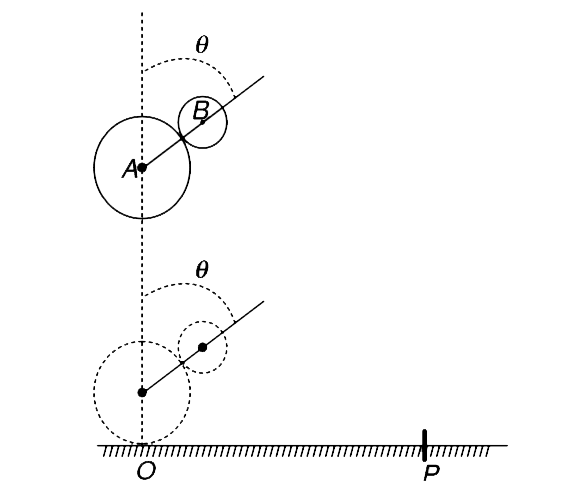A massive ball (A) is dropped from height h on a smooth horizontal floor. A smaller ball (B) is also dropped simultaneously. Initially ball B was just touching ball A (see fig.). Radii of both balls is much smaller than h. Ball A hits the floor, rebounds and immediately hits B. Motion of both the balls is vertical before the collision of two balls. All collision are elastic and there is no friction. Ball B lands at point P on the ground after colliding with A. Find OP, assuming that it is large compared to radius of A.

The correct Answer is:16hsin2θ[12+cos2θ]
Step by step video, text & image solution for A massive ball (A) is dropped from height h on a smooth horizontal floor. A smaller ball (B) is also dropped simultaneously. Initially ball B was just touching ball A (see fig.). Radii of both balls is much smaller than h. Ball A hits the floor, rebounds and immediately hits B. Motion of both the balls is vertical before the collision of two balls. All collision are elastic and there is no friction. Ball B lands at point P on the ground after colliding with A. Find OP, assuming that it is large compared to radius of A. by Physics experts to help you in doubts & scoring excellent marks in Class 11 exams.
Updated on:21/07/2023Topper's Solved these Questions
Similar Questions
" A ball is thrown horizontally and another ball is just dropped simultaneously from the top of a tower.The one that reaches the ground first is "
View SolutionA ball is dropped from a height h on to a floor . If the cofficient of restitution is e, calculate the height the ball first rebounds ?
View Solution
Knowledge Check
A ball hits the floor and rebounds after an inelastic collision. In this case
Athe momentum of he ball just after the collision is the same as that just before the collision.Bthe mechanical energy of the ball remains the same in the collisionCthe total momentum of the ball and the earth is conservedDthe total energy of the ball and the earth is conservedA ball hits the floor and rebounds after an inelastic collision. In this case
Athe momentum of the ball just after collision is same as that just before the collisionBthe mechanical energy of the ball remains the same in collisionCthe total momentum of the ball and the earth is conservedDthe total mechanical energy of the ball and the earth is conservedA ball hits the floor and rebounds after an inelastic collision . In this case-
Athe momentum of the ball just after the collision is the same as that just before the collisionBthe mechanical energy of the ball remains the same in the collisionCthe total momentum of the ball and the earth is conserved.Dthe total energy of the ball and the earth is conserved
A ball hits a floor and rebounds after an inelastic collision. In this case
View SolutionA ball is dropped from a height 'h' on to a floor of coefficient of restitution 'e'. The total distance covered by the ball just before second hit is
View SolutionA ball dropped from height h on a horizontal floor goes up to the height 3hh after hitting the floor. Fraction of energy of ball lost in the impact is
View SolutionAn elastic ball with coefficient of elasticity 1/2 is dropped from rest at a height h on a smooth floor . The total distance covered by the ball is
View SolutionIn an elastic collision between smooth balls :
View Solution
